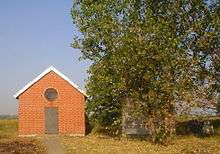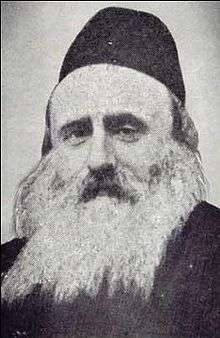Sochatchov (Hasidic dynasty)
Sochatchov (Hebrew: סוכטשוב, prounced So-kah-tchov) is a Hasidic dynasty named for the town of Sochaczew, located 25 miles (40 km) west of Warsaw[1] in central Poland. The dynasty was based in Sochaczew from 1870 until 1915. After World War I the dynasty was moved to Łódź and, subsequently, to other nearby towns. After World War II the dynasty was transplanted to Israel, where it thrives to this day.
History
Leadership in Poland

The founder of the dynasty was Rabbi Avrohom Bornsztain (also spelled Borenstein or Burnstein) (1838–1910), a leading posek (Jewish legal authority) in 19th-century Poland. He was a close disciple of the Kotzker Rebbe, Rabbi Menachem Mendel Morgenstern, and married the Kotzker Rebbe's daughter.[2] After the Kotzker Rebbe's death, Bornsztain became a Hasid of his uncle, Rabbi Yitzchak Meir Alter, the Chidushei HaRim of Ger. Following the latter's death in 1866, he became a hasid of Rabbi Chanoch Heynekh of Alexander.[3] When the Alexander Rebbe died in 1870, Bornsztain agreed to become a Hasidic rebbe himself. From 1883 until his death he served as Rav and av beis din (head of the rabbinical court) of Sochaczew (Sochatchov), becoming known as the Sochatchover Rebbe. The homilies that he delivered before his Hasidim on Shabbat were collected and printed in the book Ne'ot Deshe. His voluminous responsa on every section of Shulchan Aruch were published posthumously in seven volumes under the title Avnei Nezer ("Stones of the Crown").

His only son, Rabbi Shmuel Bornsztain, succeeded him as av beis din of Sochatchov and second Sochatchover Rebbe. From his childhood, Shmuel's primary teacher was his father, and he continued to live near him even after his marriage.[4] Upon his father's death in 1910, he was accepted as Rebbe by all his father's Hasidim. He established a Sochatchov yeshiva, Yeshivat Beit Avrohom, first in Sochaczew and later in Zgierz. He delivered many shiurim (Torah lectures) to his Hasidim on the topics of the weekly Torah portion and Jewish holidays, primarily based on the teachings of his father.[4] These teachings were posthumously published in the nine-volume Shem Mishmuel.
In 1915 the town of Sochaczew was destroyed by the German army and the Rebbe re-established his court in Łódź. In 1919 he moved his court to Zgierz, a small town near Łódź. He died in 1926.[4]

The third Sochatchover Rebbe, Rabbi Dovid Bornsztain (1876–1942), eldest son of Shmuel Bornsztain, grew up near his grandfather, the Avnei Nezer, who was his primary teacher. After his marriage, he lived in his grandfather's house, continuing to learn from him.[5][6] He served as the Rav of Vishgorod, where he established a yeshiva patterned after the Sochatchov learning style, and served as Rav of Tomashov after World War II. Upon his father's death in January 1926, Bornsztain was appointed third Sochatchover Rebbe by his father's Hasidim.[7] He established his court in Pabianice, near Łódź,[5] and founded a network of yeshivas under the name Yeshivat Beit Avrohom in Łódź, Warsaw, and other Polish cities.[7] He was an active member of Agudath Israel of America and the Moetzes Gedolei HaTorah[5] and became known as one of the generation's leading Rebbes.[5][7]
After the invasion of Poland in 1939, the Rebbe was smuggled into the Warsaw Ghetto on forged documents. His home became a center for Torah study and gatherings of rabbis and activists.[8] He supervised the education of several hundred Sochatchover yeshiva students in the ghetto.[8] When the deportations began, the Rebbe hid in a shop on 67 Genesha Street, where he died of heart failure on 17 November 1942.[7][9][10] His wife, sons, daughters, sons-in-law and grandchildren were all murdered by the Nazis in the spring of 1943. All of the Rebbe's many manuscripts were destroyed, save for a few pages containing chidushim (new Torah thoughts) on the Passover Haggadah. These pages were later published as Chasdei Dovid together with the ninth volume of Shem Mishmuel, his father's work, which deals with the Haggadah.[5]
Leadership in Israel
The fourth Sochatchover Rebbe was Rabbi Chanoch Henoch Bornsztain (d. 1965), the younger brother of Rabbi Dovid Bornsztain, who had emigrated to Palestine in 1924 and opened a beis medrash in Jerusalem.[11][12] After World War II, he accepted the request of the surviving Sochatchover Hasidim to be their leader and established his court in Jerusalem, preferring to remain in that city even during the 1948 Arab-Israeli war, when his followers in Tel Aviv urged him to join him there.[13] He led the dynasty until his death in 1965.
The fifth Sochatchover Rebbe was Rabbi Menachem Shlomo Bornsztain (1934–1969), eldest son of Rabbi Chanoch Henoch Bornsztain. He was officially known as the Sochatchover-Radomsker Rebbe, since he was the great-grandson of the third Radomsker Rebbe (through his maternal lineage) and was asked by the Radomsker Hasidim who had survived the Holocaust to become their Rebbe as well.[13] While his father was alive, he served as Rav of the Sochatchover shtiebel in Tel Aviv and Rav of the Yad Eliyahu neighborhood. He died in an automobile accident in August 1969 at the age of 34.[13]
The sixth Sochatchover Rebbe is Rabbi Shmuel Bornsztain (b. 1961), eldest son of Rabbi Menachem Shlomo Bornsztain. He was 8 years old at the time of his father's death, and became Rebbe a few years later. He presently leads the Sochatchover dynasty from Bayit Vegan, Jerusalem, where the Sochatchov yeshiva, Yeshivat Avnei Nezer, is located.[11]
Teachings
The Avnei Nezer and his son, the Shem Mishmuel, produced a body of teachings that are widely acknowledged as halakhic and homiletic Torah classics.[1][14] The homiletic essays of the Shem Mishmuel have earned a following in both the Hasidic and non-Hasidic world, and are quoted in many Torah shiurim and books.
Lineage of Sochatchov dynastic leadership
- First Sochatchover Rebbe: Avrohom Bornsztain (1838–1910), author of Avnei Nezer. Rebbe from 1870 to 1910.
- Second Sochatchover Rebbe: Shmuel Bornsztain (1856–1926), son of Avrohom Bornsztain, author of Shem Mishmuel. Rebbe from 1910 to 1926.
- Third Sochatchover Rebbe: Dovid Bornsztain (1876–1942), son of Shmuel Bornsztain. Rebbe from 1926 to 1942.
- Fourth Sochatchover Rebbe: Chanoch Henoch Bornsztain (d. 1965), son of Shmuel Bornsztain. Rebbe from the mid-1940s to 1965.
- Fifth Sochatchover Rebbe: Menachem Shlomo Bornsztain (1934–1969), son of Chanoch Henoch Bornsztain. Rebbe from 1965–1969.
- Sixth Sochatchover Rebbe: Shmuel Bornsztain (b. 1961), son of Menachem Shlomo Bornsztain. Rebbe since the 1970s.
- Fifth Sochatchover Rebbe: Menachem Shlomo Bornsztain (1934–1969), son of Chanoch Henoch Bornsztain. Rebbe from 1965–1969.
- Fourth Sochatchover Rebbe: Chanoch Henoch Bornsztain (d. 1965), son of Shmuel Bornsztain. Rebbe from the mid-1940s to 1965.
- Third Sochatchover Rebbe: Dovid Bornsztain (1876–1942), son of Shmuel Bornsztain. Rebbe from 1926 to 1942.
- Second Sochatchover Rebbe: Shmuel Bornsztain (1856–1926), son of Avrohom Bornsztain, author of Shem Mishmuel. Rebbe from 1910 to 1926.
See also
References
- 1 2 Finkel, Avraham Yaakov (1994). Contemporary Sages: The great Chasidic masters of the twentieth century. Jason Aronson. p. 46. ISBN 1-56821-155-4.
- ↑ Cejtlin, Aharon (10 July 2006). "Reb Avrahamele Sochaczewer". Sochaczew Memorial Book. jewishgen.org. Retrieved 26 December 2011.
- ↑ Saltiel, Manny (2011). "Gedolim Yahrtzeits: Adar". chinuch.org. Retrieved 15 January 2011.
- 1 2 3 Chetzroni, A. (10 July 2006). "The Shem Mishmuel". Sochaczew Memorial Book. jewishgen.org. Retrieved 26 December 2011.
- 1 2 3 4 5 Harav Dovid Bornstein — The Sochatchover Rebbe. Hamodia Features, 11 November 2010, p. C3.
- ↑ Tzemach, B. "Rabbi Dovid Borenstein, the Admor of Sochaczew". jewishgen.org. Retrieved 20 November 2010.
- 1 2 3 4 Aharonson, Rabbi Yehoshua (2009). "The Admor Rabbi Dovid of Holy Blessed Memory". jewishgen.org. Retrieved 27 December 2011.
- 1 2 Farbstein, Esther (2007). Hidden In Thunder: Perspectives on faith, halachah and leadership during the Holocaust. Feldheim Publishers. pp. 119–120. ISBN 965-7265-05-3.
- ↑ Rozett (2005). Approaching the Holocaust: Texts and contexts. Vallentine Mitchell. p. 164. ISBN 978-0-85303-581-7. Missing
|last1=in Authors list (help) - ↑ Kaliv World Center (2002). Shema Yisrael: Testimonies of devotion, courage, and self-sacrifice, 1939-1945. Targum Press. p. 288. ISBN 1-56871-271-5.
- 1 2 Rossoff, Dovid (1998). Where Heaven Touches Earth. Guardian Press. p. 471. ISBN 0-87306-879-3.
- ↑ Saltiel, Manny (2010). "Gedolim Yahrtzeits: 8 Kislev". chinuch.org. Retrieved 20 November 2010.
- 1 2 3 Growise, Yisroel Alter. The Sochatchover Rebbe, Harav Menachem Shlomo Bornstein, zt"l, 40 Years Since His Tragic Passing. Hamodia Features section, 27 August 2009, pp. C4-5.
- ↑ Wein, Berel (October 1990). Triumph of Survival: The story of the Jews in the modern era (1650–1996). Mesorah Publications. p. 97. ISBN 0-89906-498-1.